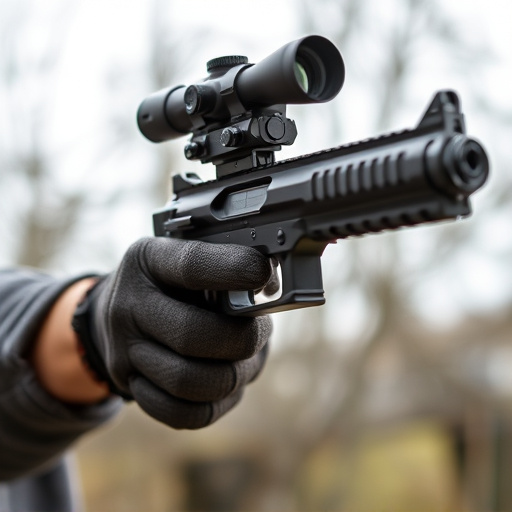Non-lethal home defense weapons, including pepper spray, stun guns, noise devices, and more, offer homeowners effective means to protect themselves and their families without causing permanent harm. Understanding these options, local laws, and safety protocols is crucial for responsible use. By balancing deterrence with practicality, individuals can choose tools like pepper spray (for close quarters), stun guns (for longer reach), or noise makers (for quick disruption) and stay prepared through regular training and practice, ensuring compliance with local regulations on non-lethal force.
In today’s world, considering non-lethal home defense options is a proactive step towards ensuring safety without resorting to deadly force. This comprehensive guide explores various tools and tactics, empowering individuals to protect themselves and their loved ones. From understanding the legal framework surrounding non-lethal weapons to choosing the right equipment, we delve into practical strategies for enhancing home security. Discover innovative solutions for peaceful protection.
Understanding Non-Lethal Home Defense Weapons
Non-lethal home defense weapons are designed to incapacitate or deter intruders without causing permanent harm, making them valuable tools for homeowners seeking to protect themselves and their families. These weapons often utilize a range of technologies, including pepper spray, stun guns, and noise devices, that can disrupt an assailant’s ability to cause serious injury or death. Pepper spray, for instance, irritates the eyes and respiratory system, temporarily disorienting the attacker. Stun guns, on the other hand, use an electric current to paralyze a person for a brief period, providing ample time for the homeowner to escape or call for help.
Noise devices, such as personal alarms or air horns, are another category of non-lethal weapons. They can startle intruders and alert neighbors, potentially deterring criminals before they cause harm. Understanding the different types of non-lethal home defense weapons available is crucial for homeowners looking to enhance their safety without resorting to lethal force.
Types of Non-Lethal Self-Defense Tools
Non-lethal self-defense tools offer a range of options for individuals seeking to protect themselves without resorting to fatal force. These tools are designed to incapacitate or deter potential attackers, providing a safe and effective means of defense. From stun guns to pepper spray, each weapon has its unique application and level of protection. Stun guns, for instance, deliver an electric shock that can temporarily paralyze an assailant, giving the user precious time to escape or call for help. Pepper spray is another popular choice, causing temporary blindness and severe irritation, which can disrupt an attacker’s advance.
Other non-lethal home defense weapons include noise devices like personal alarms and air horns, which can startle and disorient an intruder. Tasers, a form of electronic control device, use electrical current to muscle control, allowing users to disable aggressive individuals. Additionally, there are physical barriers such as steel doors, reinforced windows, and security cameras that serve as visual deterrents and provide early warning systems for potential threats. These non-lethal options empower individuals to take charge of their safety while avoiding the devastating consequences of lethal force.
Legal Considerations and Safety Protocols
When exploring non-lethal home defense options, understanding legal considerations and safety protocols is paramount. Each jurisdiction has specific laws regarding the possession and use of non-lethal weapons for self-defense, so it’s crucial to familiarize yourself with these regulations to ensure compliance. Legal experts advise that individuals should check their state or local statutes to comprehend the permitted types of non-lethal defense tools and the circumstances under which they can be employed.
Safety protocols are equally significant to guarantee responsible use and minimize risks. This includes proper training on how to handle and deploy non-lethal weapons effectively while adhering to de-escalation techniques. Users must also be cognizant of their surroundings, ensuring that force is only applied as a last resort when faced with an imminent threat. Regular maintenance and storage of these devices in secure locations are additional safety measures to prevent unauthorized access and accidental use.
Choosing the Right Non-Lethal Weapon for Your Home Protection
When considering non-lethal home defense options, it’s crucial to select a weapon that strikes a balance between deterrence and effectiveness. The right choice depends on several factors, including your specific needs, living environment, and personal comfort level. Start by evaluating potential threats you might face in your home, such as intruders or aggressive animals. Next, consider the range, power, and ease of use of various non-lethal weapons like pepper spray, stun guns, or noise makers. Pepper spray is ideal for close-quarters protection against multiple aggressors, while stun guns offer a longer reach with an electric shock to disable an attacker temporarily. Noise makers, like alarms or whistles, can startle and scare off potential intruders quickly.
Remember that each weapon has its strengths and limitations, so it’s essential to train and practice with your chosen non-lethal home defense option. Regularly updating your skills ensures you’re prepared for any situation. Additionally, familiarize yourself with local laws regarding the use of non-lethal force to ensure compliance and avoid legal repercussions. By making an informed decision and staying prepared, you can enhance your home protection while adhering to responsible use guidelines.
